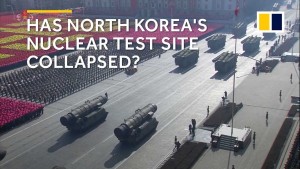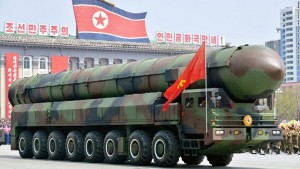By Geoffrey Grider
North Korea’s mountain nuclear test site has collapsed, putting China and other nearby nations at unprecedented risk of radioactive exposure, two separate groups of Chinese scientists studying the issue have confirmed.
The collapse after five nuclear blasts may be why North Korean leader Kim Jong-un declared that he would freeze the hermit state’s nuclear and missile tests and shut down the site, one researcher said.
The last five of Pyongyang’s six nuclear tests have all been carried out under Mount Mantap at the Punggye-ri nuclear test site in North Korea’s northwest.
One group of researchers found that the most recent blast tore open a hole in the mountain, which then collapsed upon itself. A second group concluded that the breakdown created a “chimney” that could allow radioactive fallout from the blast zone below to rise into the air.
A research team led by Wen Lianxing, a geologist with the University of Science and Technology of China in Hefei, concluded that the collapse occurred following the detonation last autumn of North Korea’s m ost powerful thermal nuclear warhead in a tunnel about 700 metres (2,296 feet) below the mountain’s peak.
ost powerful thermal nuclear warhead in a tunnel about 700 metres (2,296 feet) below the mountain’s peak.
The test turned the mountain into fragile fragments, the researchers found.
The mountain’s collapse, and the prospect of radioactive exposure in the aftermath, confirms a series of exclusive reports by the South China Morning Post on China’s fears that Pyongyang’s latest nuclear test had caused a fallout leak.
Radioactive dust could escape through holes or cracks in the damaged mountain, the scientists said.
“It is necessary to continue monitoring possible leaks of radioactive materials caused by the collapse incident,” Wen’s team said in the statement. The findings will be published on the website of the peer-reviewed journal, Geophysical Research Letters, likely next month.
North Korea saw the mountain as an ideal location for underground nuclear experiments because of its elevation – it stood more than 2,100 metres (6,888 feet) above sea level – and its terrain of thick, gentle slopes that seemed capable of resisting structural damage.
The mountain’s surface had shown no visible damage after four underground nuclear tests before 2017.
But the 100-kiloton bomb that went off on September 3 vaporized surrounding rocks with unprecedented heat and opened a space that was up to 200 metres (656 feet) in diameter, according to a statement posted on the Wen team’s website recently.
 As shock waves tore through and loosened more rocks, a large section of the mountain’s ridge, less than half a kilometre (0.3 mile) from the peak, slipped down into the empty pocket created by the blast, leaving a scar visible in satellite images.
As shock waves tore through and loosened more rocks, a large section of the mountain’s ridge, less than half a kilometre (0.3 mile) from the peak, slipped down into the empty pocket created by the blast, leaving a scar visible in satellite images.
Wen concluded that the mountain had collapsed after analyzing data collected from nearly 2,000 seismic stations.
Three small earthquakes that hit nearby regions in the wake of the collapse added credence to his conclusion, suggesting the test site had lost its geological stability. Another research team led by Liu Junqing at the Jilin Earthquake Agency with the China Earthquake Administration in Changchun reached similar conclusions to the Wen team.
The mountain’s collapse has likely dealt a huge blow to North Korea’s nuclear program, Hu said. Hit by crippling international economic sanctions over its nuclear ambitions, the country might lack sufficient resources to soon resume testing at a new site, he said.







